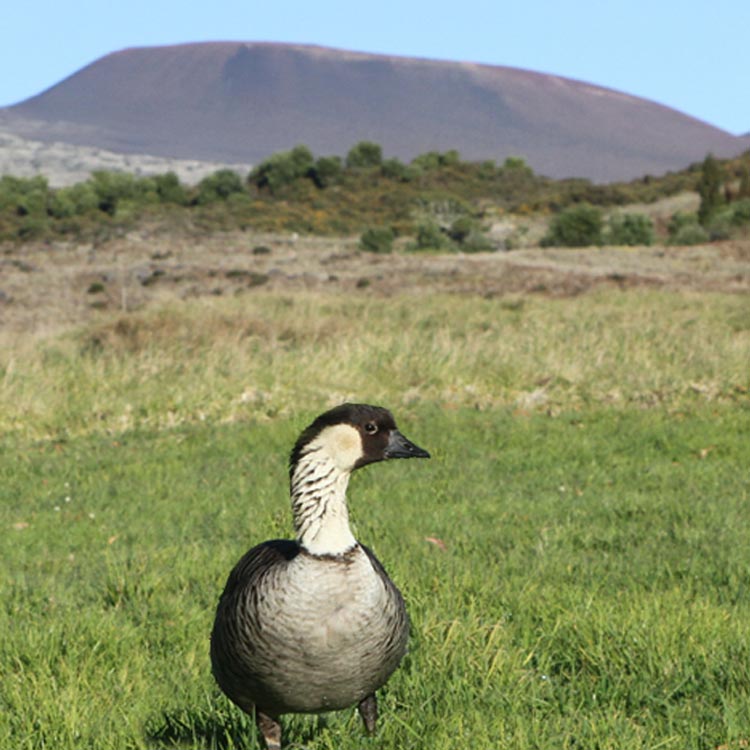
a web page by Don Roberson |
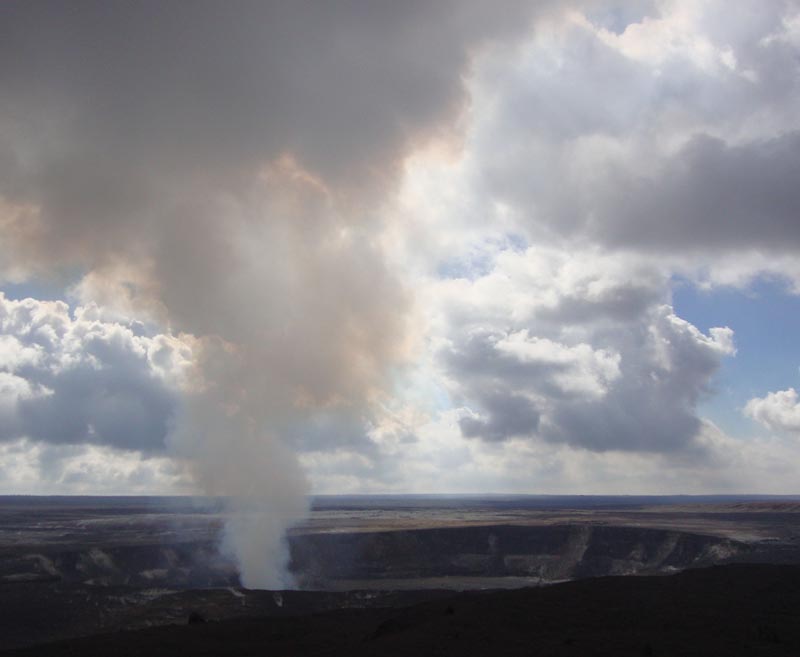 During
the Christmas holidays of 2011-2012, Rita and I visited three of the
Hawaiian Islands in search of endemic birds. [I had previously visited
briefly in Aug 1989; this page includes one species seen then but
missed this trip.]
During
the Christmas holidays of 2011-2012, Rita and I visited three of the
Hawaiian Islands in search of endemic birds. [I had previously visited
briefly in Aug 1989; this page includes one species seen then but
missed this trip.]
Most of these photos are from the "Big Island" of Hawaii. The Kilauea Caldera was active in Hawaii Volcanoes National Park, spewing extensive steam throughout the day (left) that contributed to a sulfurous "vog" over parts of the island. At night, though, the glow from the active lava could be seen (below).
The rarer native birds are restricted to high elevation cloud forests on Hawaii and on Maui, and access to protected areas is restricted. We had obtained permits long in advance by hiring Jack Jeffrey as our guide for a day in the Hakalau NWR on Hawaii. On Maui, we had arranged for Chuck Probst to guide as a docent into the Nature Conservancy's Waikamoi Preserve.
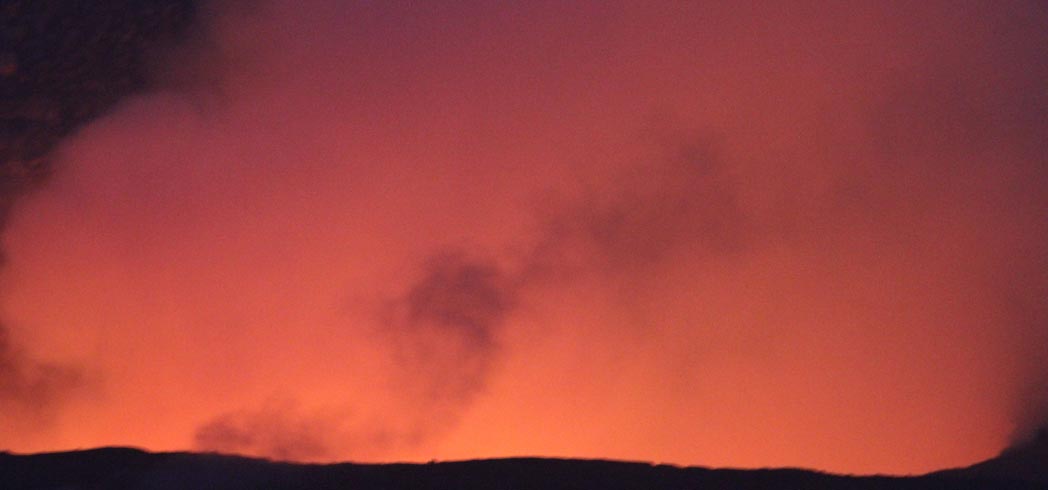
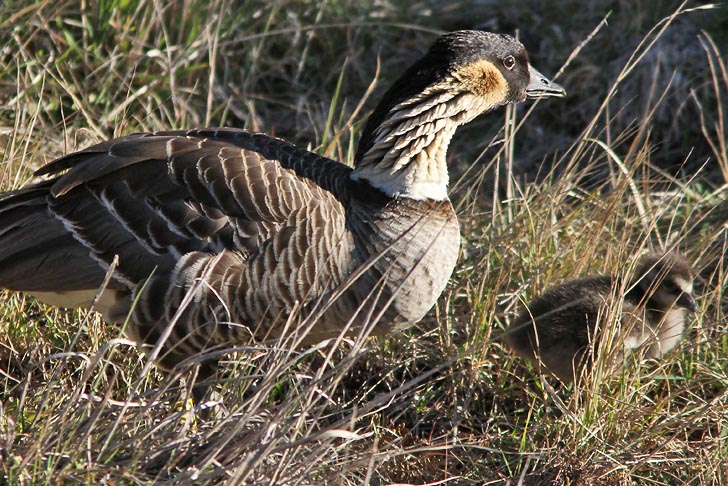
Nene [Hawaiian Goose] Branta sandvicensis is found on sparsely vegetated slopes on the volcanoes of Hawaii. The photo at the top of the page shows an adult with the summit of Mauna Kea in the background. Active re-introduction programs have aided populations on Hawaii, and permitted re-establishment of a small population within Haleakala National Park, Maui (left). There we found a pair with a recently hatched precocial young.
On Maui we also observed the Hawaiian Coot Fulica alai, and the Hawaiian races of Black-crowned Night-Heron Nycticorax nycticorax hoactli and Black-necked Stilt [Ae'o] Himantopus mexicanus knudseni. All are shown below in this photo from Kealia Pond NWR. [The wader at top left is a migrant Long-billed Dowitcher.]
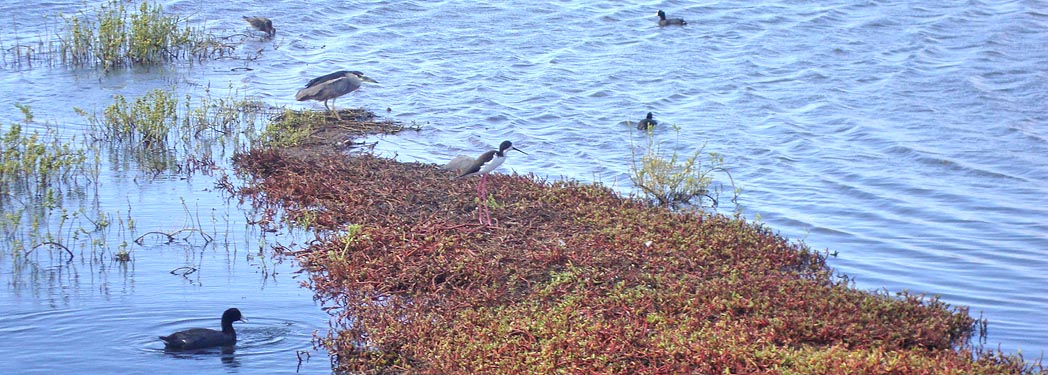
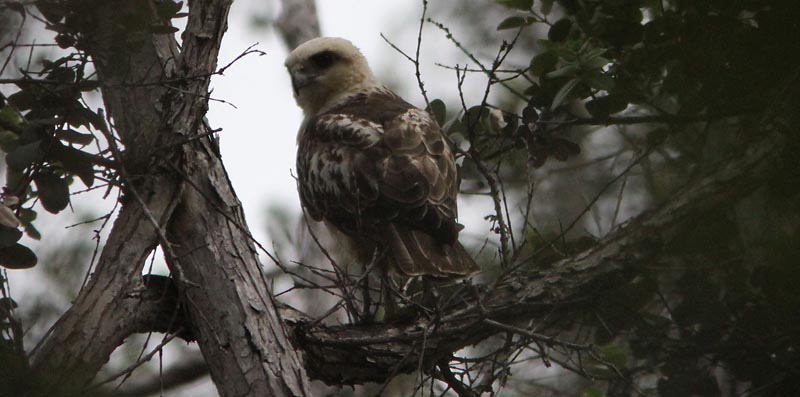
Hawaiian Hawk ['Io] Buteo solitarius is found on the 'Big Island' only, where dark morphs and light morphs are both present. [We saw some of each]. It must be doing reasonably well as we saw 4 different individuals in a single day along the Kona coast. One light morph flew in and perched above us at Manuka State Park (right). The hawk takes small birds regularly, and the woods came alive with scolding songbirds when this individual appeared.
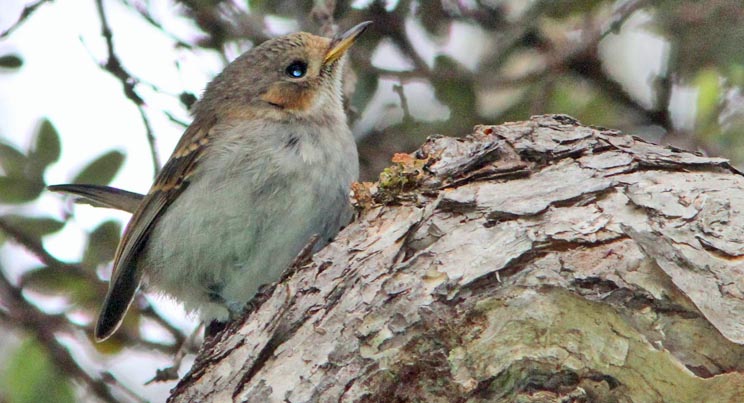 Hawaii 'Elepaio Chasiempis sandwichensis
has three distinctive populations on Hawaii. We saw representatives of
all three groups [Hilo coast, Kona coast, and Mauna Kea groups]. This
young bird (left) at Hakalau NWR is a member of the Hilo coast
population.
Hawaii 'Elepaio Chasiempis sandwichensis
has three distinctive populations on Hawaii. We saw representatives of
all three groups [Hilo coast, Kona coast, and Mauna Kea groups]. This
young bird (left) at Hakalau NWR is a member of the Hilo coast
population.
'Elepaio is the only member of the Monarchidae to reach Hawaii. The rest of the Old World family is found in Australasia and the south Pacific. It is a very active little flycatcher, often cocking its tail up, and I had difficulty obtaining one shot.
On Oahu, we searched for Oahu 'Elepaio C. gayi, and heard it at Kuli'ou'ou Valley, but only I got a very quick glimpse.
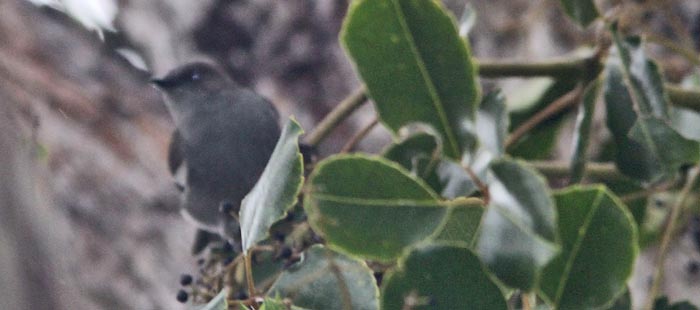
'Oma'o Myadestes obscurus is a small grayish thrush that is fairly common in forest on Hawaii, but difficult see. Our birds at Hakalau NWR were visiting a fruiting tree (right).
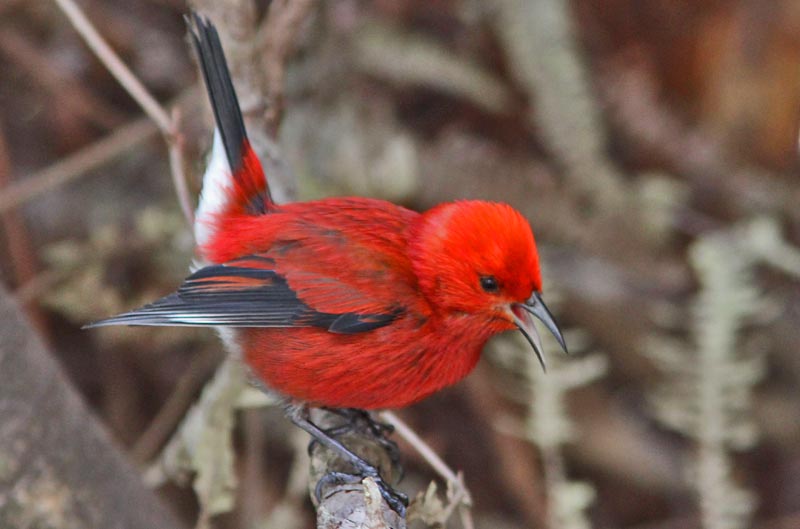 It
is, of course, the Hawaiian honeycreepers which represent the greatest
example of adaptive radiation on earth. From a single fringillid
ancestor that reached the Hawaiian Islands from Asia, the honeycreepers
evolved into ~60 species. Only 16 are apparently extant today. Yet at
least two have adapted reasonably well in the face of habitat loss,
rats, mongoose, and avian cholera. One of these is 'Apapane Himatione sanguinea, with populations on all the main islands, and found in good numbers on Maui and Hawaii.
It
is, of course, the Hawaiian honeycreepers which represent the greatest
example of adaptive radiation on earth. From a single fringillid
ancestor that reached the Hawaiian Islands from Asia, the honeycreepers
evolved into ~60 species. Only 16 are apparently extant today. Yet at
least two have adapted reasonably well in the face of habitat loss,
rats, mongoose, and avian cholera. One of these is 'Apapane Himatione sanguinea, with populations on all the main islands, and found in good numbers on Maui and Hawaii. 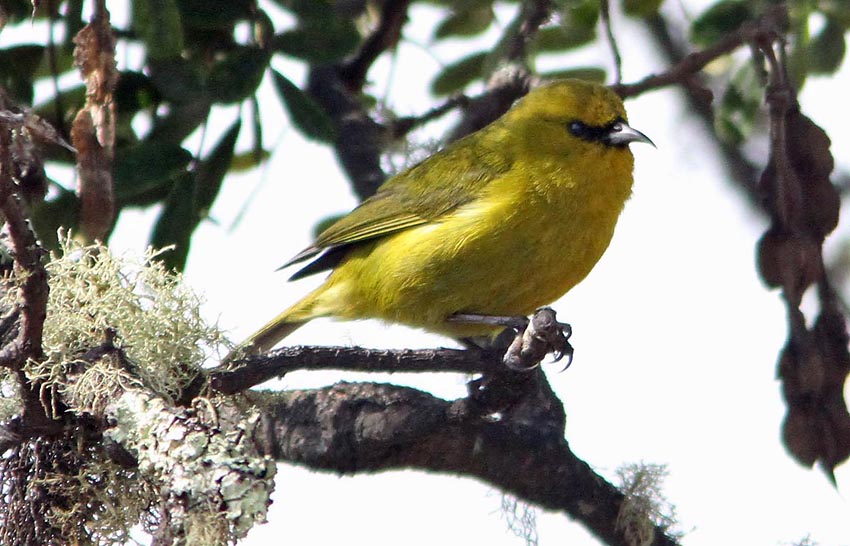 The other common honeycreeper is Hawaiian 'Amakihi Hemignathus virens,
with populations on Maui and Hawaii. On the 'Big Island' they were
common from dry forests on the Kona coast to high elevation koa forests
on Mauna Kea. This photo is one of those high-elevation birds, and it
is a brightly colored male with a crisp black mask. Females are duller,
greener, and can appear to lack masks.
The other common honeycreeper is Hawaiian 'Amakihi Hemignathus virens,
with populations on Maui and Hawaii. On the 'Big Island' they were
common from dry forests on the Kona coast to high elevation koa forests
on Mauna Kea. This photo is one of those high-elevation birds, and it
is a brightly colored male with a crisp black mask. Females are duller,
greener, and can appear to lack masks.
While on Oahu, we searched out Oahu 'Amakihi H. ellisianus, which is a greener species and without the mask.
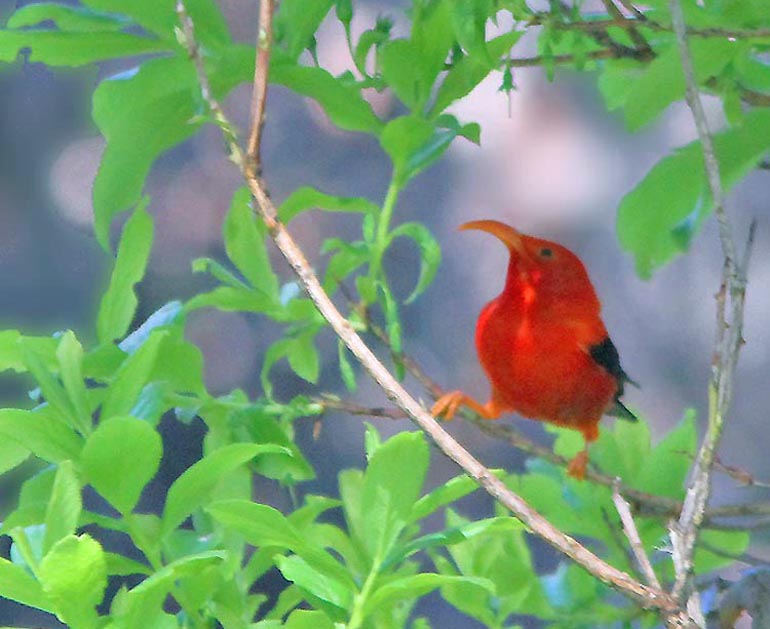
The 'I'iwi Vestiaria coccinea is the 'classic' Hawaiian honeycreeper — surely the best known from its use in commercial ventures as an icon of Hawaii — but its populations are now limited to high elevations on Maui and Hawaii. At Hakalau NWR it was the commonest species encountered. Yet it is so quick and active, and spends so much time with its bill buried in a flower, that I found it very difficult to photograph.
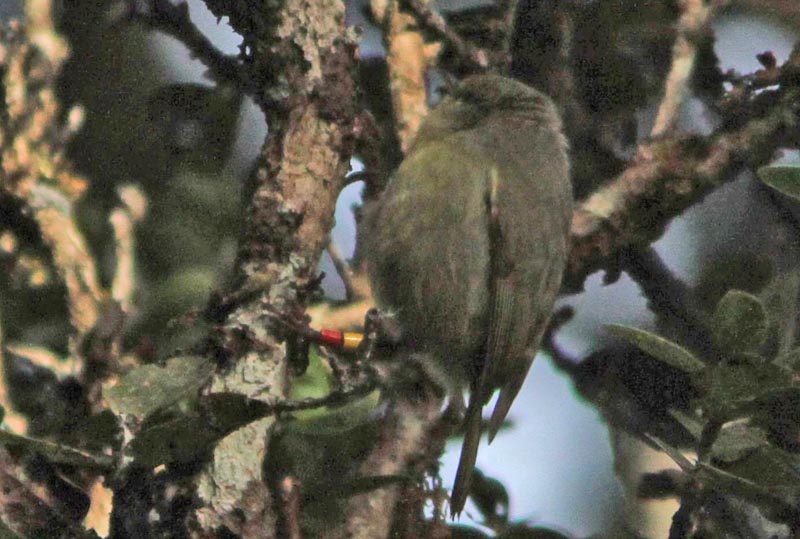 At high elevations in the cloud forest on the back side of Haleakala, Maui, lives the Maui 'Alawahio Paroreomyza montana,
formerly known as Maui Creeper. It is a small and rather plain bird
that tends to forage along branches and trunks, creeper-like, and
preferring the shade and undergrowth. This one (right) is a very dull
immature without distinctive markings [except the red-and-yellow bands
on one leg, placed there by a researcher]. Adult males are much
brighter and more yellow.
At high elevations in the cloud forest on the back side of Haleakala, Maui, lives the Maui 'Alawahio Paroreomyza montana,
formerly known as Maui Creeper. It is a small and rather plain bird
that tends to forage along branches and trunks, creeper-like, and
preferring the shade and undergrowth. This one (right) is a very dull
immature without distinctive markings [except the red-and-yellow bands
on one leg, placed there by a researcher]. Adult males are much
brighter and more yellow. 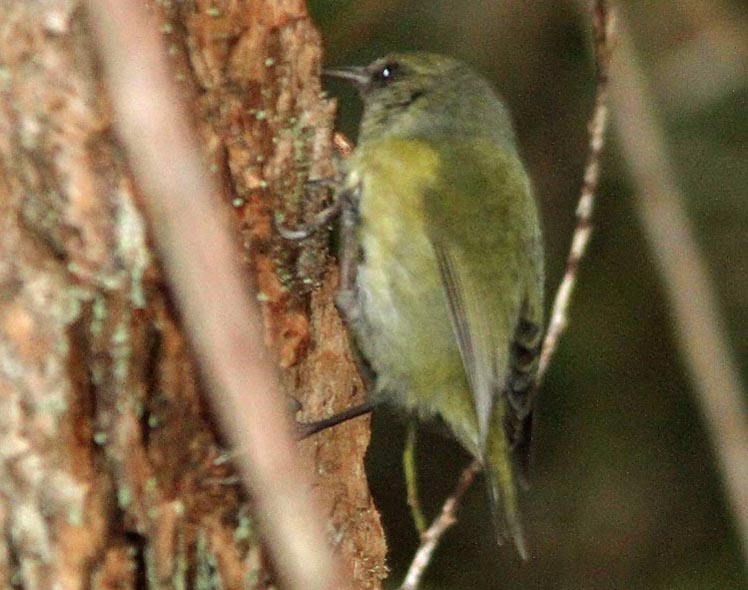 At
high elevations in cloud forest on Hawaii, is another creeper — not
closely related to 'Alawahio but which also spends its time foraging in
the shadows along trunks and branches — known as Hawaii Creeper Oreomystis mana.
The Hawaiian name used for this bird is not clear. It is Endangered
with less than 10,000 birds left. Look how different it looks in
natural light from above (below) than it does from the side with flash
(left).
At
high elevations in cloud forest on Hawaii, is another creeper — not
closely related to 'Alawahio but which also spends its time foraging in
the shadows along trunks and branches — known as Hawaii Creeper Oreomystis mana.
The Hawaiian name used for this bird is not clear. It is Endangered
with less than 10,000 birds left. Look how different it looks in
natural light from above (below) than it does from the side with flash
(left).
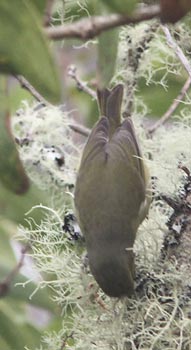
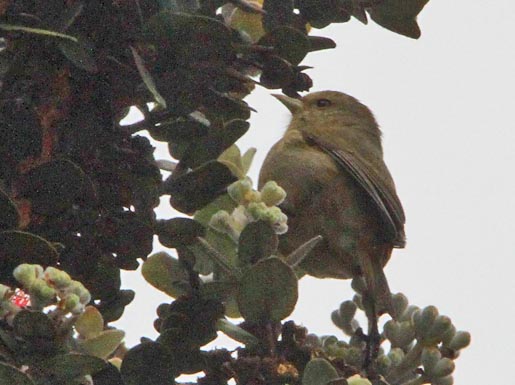 |
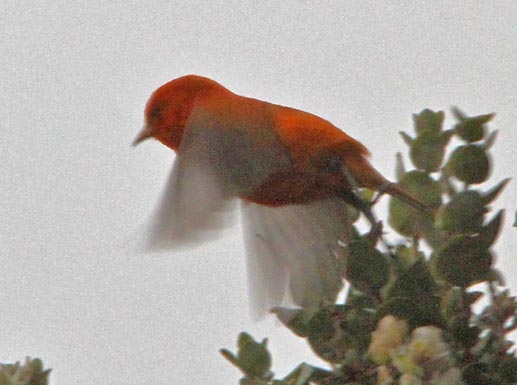 |
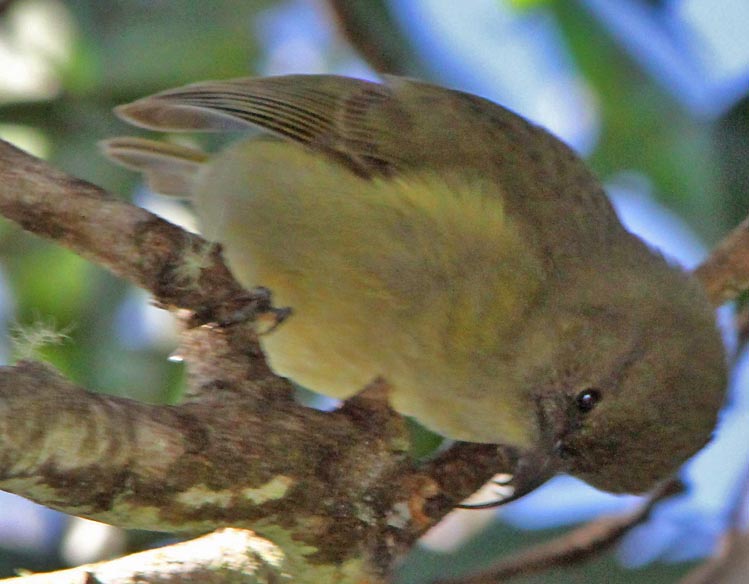 The 'Akiapola'au Hemignathus munroi (left
& below) is found only in native 'ohi'a-koa forests on Hawaii above
3500' elev. on the eastern slope of Mauna Kea. It feeds primarily on
the larvae of a bark-beetle, which it locates by using the stout lower
mandible to peck — woodpecker-like — on small limbs, and then removes
with its very long and decurved upper mandible and prehensile tongue
(see below). It is one of the most remarkable of all Hawaiian
honeycreepers.
The 'Akiapola'au Hemignathus munroi (left
& below) is found only in native 'ohi'a-koa forests on Hawaii above
3500' elev. on the eastern slope of Mauna Kea. It feeds primarily on
the larvae of a bark-beetle, which it locates by using the stout lower
mandible to peck — woodpecker-like — on small limbs, and then removes
with its very long and decurved upper mandible and prehensile tongue
(see below). It is one of the most remarkable of all Hawaiian
honeycreepers.
With Jack Jeffrey at Hakalau Reserve, we hiked through three known territories of pairs that had each fledged a single young. These young birds gave loud contact calls often, and this permitted us to locate all three of the youngsters by sound — two of them were located and watched for extensive periods. It is classified as Endangered, with only 1200 birds estimated to exist within its fragmented habitat. It was certainly the avian highlight of this trip.
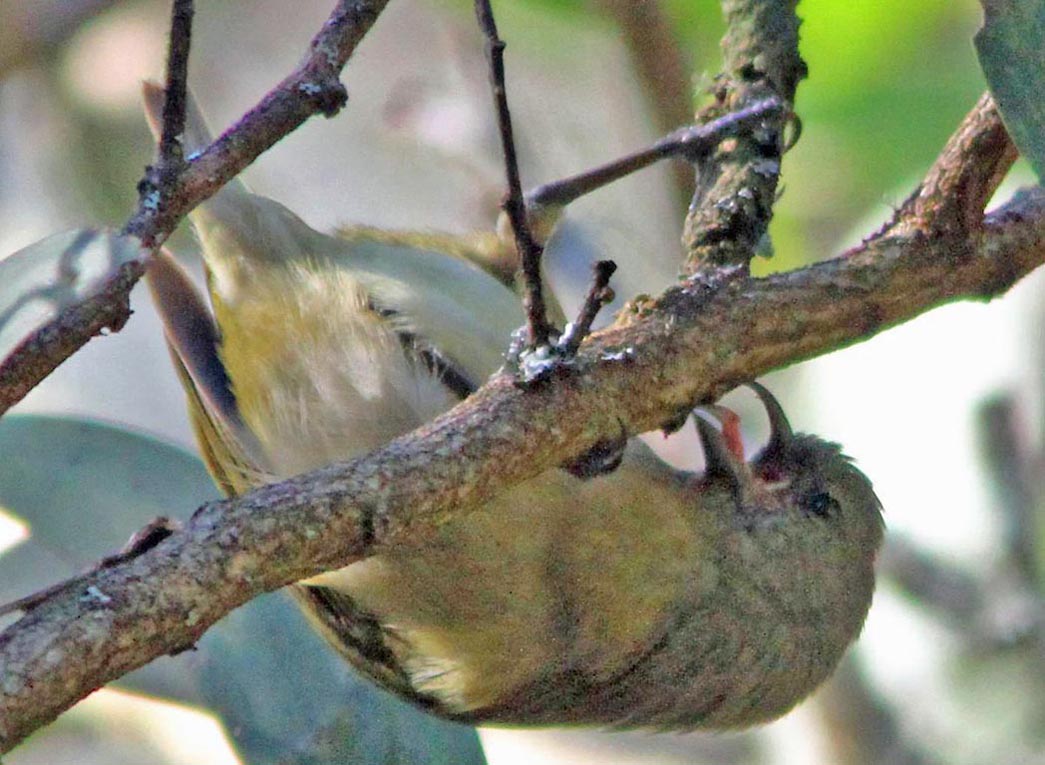
On a previous visit to Hawaii in late August 1989, I got to see and photograph a couple more species. On Hawaii we arranged for a guided tour of Hakalau NWR with refuge biologist Jack Jeffrey (right, in 1989 photo). Jack was our guide again in 2012. But back in 1989 he also took us high up the northwest slope of Mauna Kea, where a couple Palila Loxioides bailleui were seen (below left). We tried again at a 'stake-out' spot in 2012, but missed it. In 1989, I visited Kauai as well, picking up 3 other honeycreepers endemic to that island, including the bright yellow 'Anianiau Hemignathus parvus (below right). I understand that it has become much more difficult to find now. |
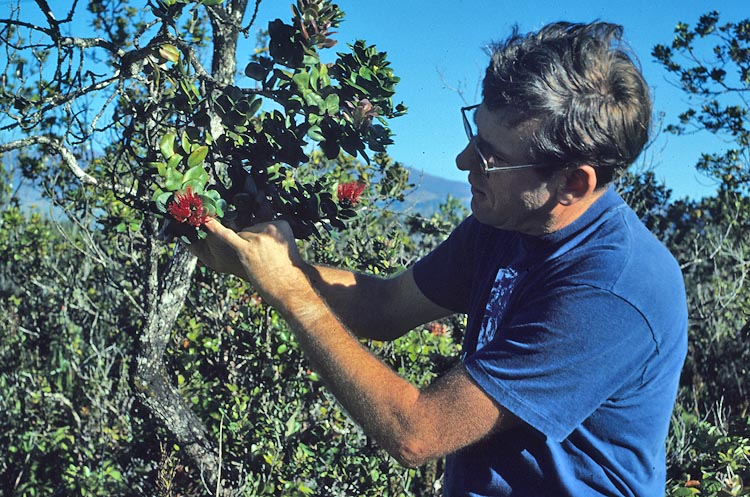 |
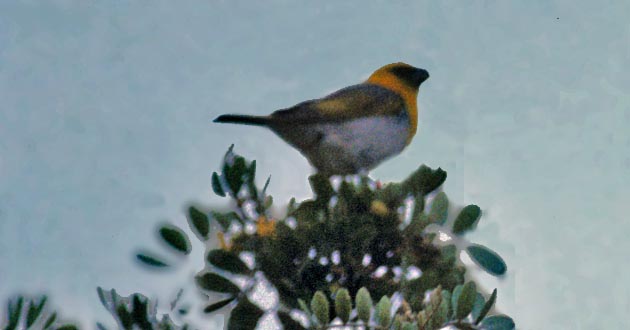 |
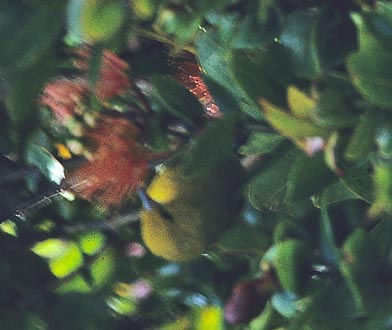 |